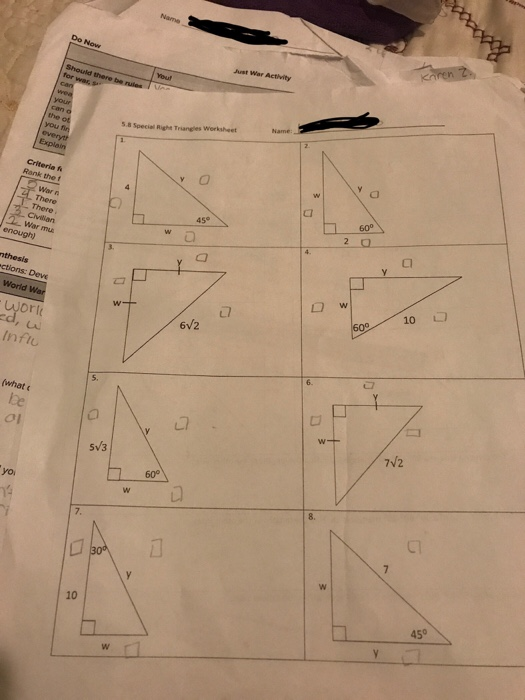


Students need to get back their ORIGINAL paper so they can check over the persons work. They will sign their name in the box that they just completed.

Students will switch papers with the person they pair up with and choose a problem on the other persons paper to complete. When they are finished, they stand up, raise their hand ,and look for somebody else who has their hand raised. Once they complete the problem, I have them sign their name at the bottom of the box. The first thing that I tell students to do, is to "Write their name at the top of the paper." Next, I tell students to choose only ONE out of the 12 problems to complete. On the third day, we practiced some more with a "Stands Up-Hands Up-Pair Up" activity.ĭirections: I hand out the Special Right Triangles: Hands Up-Pair Up to every student. They will now tell other students that in a 45-45-90 triangle, the "hypotenuse is always √2 times longer than the leg". I feel like the discovery and the "why" helped them the most. My special education students are ROCKIN' special right triangles. Overall, I feel like this lesson went GREAT. On the 30 60 90 paper, I told students that each side of the equilateral triangle is 2 inches and that they need to find the length of the altitude. Many students told me that the hypotenuse is always √2 times longer than the leg "because the Pythagorean Theorem says so." After students used the Pythagorean Theorem to find the length of the diagonal of the square, I asked them to tell me the relationship between the legs and the hypotenuse of a 45-45-90 triangle.

I told students that each side of the square was 1 cm and they had to use the Pythagorean Theorem to find the length of the diagonal. They had to use the Pythagorean Theorem to solve for the length of the diagonal (square) and the altitude (equilateral triangle). So, I had students discover the rules for 45-45-90 and 30-60-90 triangles by splitting a square in half and an equilateral triangle in half. Newell, why is the hypotenuse in a 45-45-90 triangle always √2 times longer than the legs? Why isn't it only 2 times the leg, since 45 is half of 90?" This question made me reflect on my teaching and it made me realize that I was not teaching the "why" in special right triangles. 5♷ = 35, so the 3rd side length is 35.This is my third year teaching Geometry and every year, students have a hard time with special right triangles. First, reduce the side lengths by a common denominator. Let’s figure out which side-based special right triangle this is. 13♴ = 52, so the 3rd side length is 52.Ī triangle has side lengths of 21 and 28. So, the 3rd side length is 2♵ = 10.Ī triangle has side lengths of 20 and 48. We can see from the two given sides that a = 5 and we are missing the 2a side. The 30-60-90 relationship tells us that the side lengths are a, 2a, and a√3. This must be a 30-60-90 triangle because of the two given angles. Ī triangle has side two internal angles of 30° and 90°, and two side lengths of 5 and. Since the leg is 10, the hypotenuse/ 3rd side length is. The 45-45-90 triangle relationship tells us that the hypotenuse is square root of 2 times the leg. A 45-45-90 triangle has two sides with a length of 10.


 0 kommentar(er)
0 kommentar(er)
